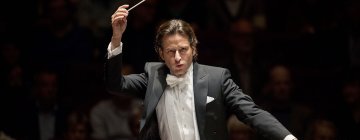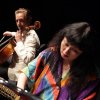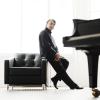The Music@Menlo Chamber Music Festival is known to occasionally insert a vocal piece into its otherwise purely instrumental repertoire. But this year, the programmers decided to present a rare concert of vocal chamber music, held Sunday, Aug. 3, at Menlo School’s Spieker Center for the Arts.
Adding a human voice to chamber music alters the experience for everyone involved. For the audience, the lyrics can add a new, explicit layer of meaning. Even for listeners who don’t pay much attention to the words, the timbre of the voice is a different and distinctive sound.
The first of the “Let’s Add Voices!” concert’s three parts consisted of songs for piano and other instruments. Baritone John Moore sang four arrangements of Scottish folk airs by Carl Maria von Weber. Scottish publisher George Thomson commissioned Weber, as he had previously done for Haydn and Beethoven. In addition to the usual piano trio accompaniment, Weber added a flute.
These are pleasant, workmanlike arrangements intended for amateurs to play, and Moore sang them in a deep and formal tone, solemnly presenting the one song in Scottish dialect, “O poortith cauld,” from a poem by Robert Burns.
This was followed by the two songs of Johannes Brahms’s Op. 91, dedicated to his friends, the famous violinist Joseph Joachim and his wife Amalie Marie Joachim, a singer. The songs were written for mezzo-soprano, viola (which Joseph also played), and piano.
Marie Therese Carmack’s voice came across as thickly textured and a little distant. The viola part, played by Tien-Hsin Cindy Wu, was quite elaborate, framing the songs by entering before the voice, and continuing during the vocal part with thoughtful counterpoint. Gilbert Kalish was the pianist.
The concert’s second part consisted of two works with a string quartet accompanying, each exceedingly different from the other: Samuel Barber’s setting of Matthew Arnold’s poem Dover Beach, and Brett Dean’s And Once I Played Ophelia.
Moore’s vocal line in Dover Beach was primarily concerned with phrasing, while the quartet carried the emotional content of the piece. Written more in counterpoint to the vocal line than as accompaniment, the quartet makes a quietly shattering conclusion by returning to the opening's simple oscillations for the final devastating lines of the poem.
The Viano Quartet performed on And Once I Played Ophelia, and though the music gives lengthy instrumental supplements, this work belonged to its singer, soprano Tony Arnold. The text, adapted by Matthew Jocelyn from Shakespeare’s Hamlet, consists more of words spoken to or about Ophelia than by her. Arnold acted more than she sang, angrily spitting out Hamlet’s “Get thee to a nunnery,” gulping and hardly able to enunciate his line “Never doubt I love,” and speaking scornfully of her father Polonius calling her a “green girl.” This piece was even more stunningly intense than the Barber.
Leonard Bernstein’s Arias and Barcarolles, a song cycle for two voices and piano four-hands, didn’t quite fit into the program’s premise. Two pianists don’t make a chamber ensemble, and in any case some of the work’s numbers have only one pianist.
The comic and self-reflective lyrics of much of the cycle demand a more ironic, self-knowing approach than did the earlier serious songs. Moore and Carmack sang accordingly with lighter and smaller voices than they’d used before, not neglecting to mug at each other at appropriate moments in the dialogues. Hyeyeon Park and Gloria Chien were the pianists.
The closest thing to a serious art song in Bernstein’s cycle is a piece for the baritone in Yiddish, “Oif Mayn Khas’neh.” Moore sang with good pronunciation but not much sense of the inflections of Yiddish. It’s no more a native language for him than was the Scottish dialect of the Burns poem. Moore presented himself well, if he was stepping outside his comfort zone in these numbers, as did all the other performers.




